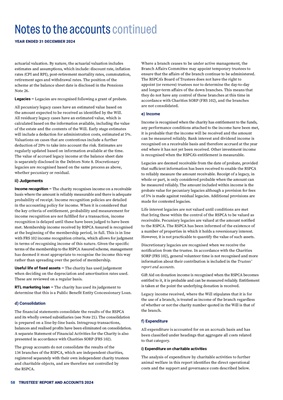
TRUSTEES' REPORT AND ACCOUNTS 2024
58
actuarial valuation. By nature, the actuarial valuation includes
estimates and assumptions, which include: discount rate, inflation
rates (CPI and RPI), post-retirement mortality rates, commutation,
retirement ages and withdrawal rates. The position of the
scheme at the balance sheet date is disclosed in the Pensions
Note 26.
Legacies - Legacies are recognised following a grant of probate.
All pecuniary legacy cases have an estimated value based on
the amount expected to be received as identified by the Will.
All residuary legacy cases have an estimated value, which is
calculated based on the information available, including the value
of the estate and the contents of the Will. Early stage estimates
will include a deduction for administration costs, estimated at 5%.
Valuations on cases that are contentious include a further
deduction of 20% to take into account the risk. Estimates are
regularly updated based on information available at the time.
The value of accrued legacy income at the balance sheet date
is separately disclosed in the Debtors Note 8. Discretionary
legacies are recognised based on the same process as above,
whether pecuniary or residual.
ii) Judgements
Income recognition - The charity recognises income on a receivable
basis where the amount is reliably measurable and there is adequate
probability of receipt. Income recognition policies are detailed
in the accounting policy for income. When it is considered that
the key criteria of entitlement, probability and measurement for
income recognition are not fulfilled for a transaction, income
recognition is delayed until these have been judged to have been
met. Membership income received by RSPCA Assured is recognised
at the beginning of the membership period, in full. This is in line
with FRS 102 income recognition criteria, which allows for judgment
in terms of recognising income of this nature. Given the specific
terms of the membership to the RSPCA Assured scheme, management
has deemed it most appropriate to recognise the income this way
rather than spreading over the period of membership.
Useful life of fixed assets - The charity has used judgement
when deciding on the depreciation and amortisation rates used.
These are reviewed on a regular basis.
RTL marketing loan - The charity has used its judgement to
determine that this is a Public Benefit Entity Concessionary Loan.
d) Consolidation
The financial statements consolidate the results of the RSPCA
and its wholly owned subsidiaries (see Note 21). The consolidation
is prepared on a line-by-line basis. Intragroup transactions,
balances and realised profits have been eliminated on consolidation.
A separate Statement of Financial Activities for the Charity is also
presented in accordance with Charities SORP (FRS 102).
The group accounts do not consolidate the results of the
134 branches of the RSPCA, which are independent charities,
registered separately with their own independent charity trustees
and charitable objects, and are therefore not controlled by
the RSPCA.
Where a branch ceases to be under active management, the
Branch Affairs Committee may appoint temporary trustees to
ensure that the affairs of the branch continue to be administered.
The RSPCA's Board of Trustees does not have the right to
appoint (or remove) trustees nor to determine the day-to-day
and longer-term affairs of the down branches. This means that
they do not have any control of these branches at this time in
accordance with Charities SORP (FRS 102), and the branches
are not consolidated.
e) Income
Income is recognised when the charity has entitlement to the funds,
any performance conditions attached to the income have been met,
it is probable that the income will be received and the amount
can be measured reliably. Bank interest and dividend income is
recognised on a receivable basis and therefore accrued at the year
end where it has not yet been received. Other investment income
is recognised when the RSPCA's entitlement is measurable.
Legacies are deemed receivable from the date of probate, provided
that sufficient information has been received to enable the RSPCA
to reliably measure the amount receivable. Receipt of a legacy, in
whole or part, is only considered probable when the amount can
be measured reliably. The amount included within income is the
probate value for pecuniary legacies although a provision for fees
of 5% is made against residual legacies. Additional provisions are
made for contested legacies.
Life interest legacies are not valued until conditions are met
that bring these within the control of the RSPCA to be valued as
receivable. Pecuniary legacies are valued at the amount notified
to the RSPCA. The RSPCA has been informed of the existence of
a number of properties in which it holds a reversionary interest.
However, it is not practicable to quantify the value of such assets.
Discretionary legacies are recognised when we receive the
notification from the trustee. In accordance with the Charities
SORP (FRS 102), general volunteer time is not recognised and more
information about their contribution is included in the Trustees'
report and accounts.
Gift Aid on donation income is recognised when the RSPCA becomes
entitled to it, it is probable and can be measured reliably. Entitlement
is taken at the point the underlying donation is received.
Legacy income received, where the Will stipulates that it is for
the use of a branch, is treated as income of the branch regardless
of whether or not the charity number quoted in the Will is that of
the branch.
f) Expenditure
All expenditure is accounted for on an accruals basis and has
been classified under headings that aggregate all costs related
to that category.
i) Expenditure on charitable activities
The analysis of expenditure by charitable activities to further
animal welfare in this report identifies the direct operational
costs and the support and governance costs described below.
Notes to the accounts continued
YEAR ENDED 31 DECEMBER 2024